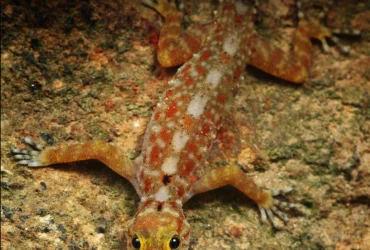Archives
 v12i1.295
v12i1.295ISSN: 1800-427X (printed)
eISSN: 1800-427X (online)
DOI:10.47605/tapro.v12i1.295
Submitted date: 18 March 2023
Accepted date: 3 May 2023
Published date: 12 May 2023
Pp. 5–13, pls. 4–6.
A NEW RUPICOLOUS DAY GECKO SPECIES (SQUAMATA: GEKKONIDAE: Cnemaspis) FROM TAMIL NADU, SOUTH INDIA
Amit Sayyed*, Samson Kirubakaran, Rahul Khot, Anbazhagan Abinesh, Shiva Harshan, Ayaan Sayyed, Masum Sayyed, Omkar Adhikari, Jayaditya Purkayastha,
Shubhankar Deshpande & Shauri Sulakhe
*Corresponding author. E-mail: amitsayyedsatara@gmail.com
Abstract
We here describe a new rupicolous day gecko species nested within the C. gracilis clade from Madurai, Tamil Nadu, India. The new species differs with a combination of morphological characters and molecular phylogenetics, from other closely related congeners. The sequence divergence of the new species in comparison with the congeners from the gracilis clade is 6.1–15.2% for the ND2 gene. The new species can also be differentiated from the congeners based on the following combination of morphological characters: conical and spine-like tubercles absent on flanks; adult SVL less than 35.0 mm; two precloacal pores; precloacal pores separated medially by two poreless scales; four femoral pores; number of mid-ventral scales 110–120; and a small black colour spot on the occiput.
Key words : dwarf geckos, [i]gracilis[.i[ clade, molecular phylogeny, ND2, rock-dwelling, systematics
Section Editor: Zeeshan Mirza
LSID:urn:lsid:zoobank.org
eISSN: 1800-427X (online)
DOI:10.47605/tapro.v12i1.295
Submitted date: 18 March 2023
Accepted date: 3 May 2023
Published date: 12 May 2023
Pp. 5–13, pls. 4–6.
A NEW RUPICOLOUS DAY GECKO SPECIES (SQUAMATA: GEKKONIDAE: Cnemaspis) FROM TAMIL NADU, SOUTH INDIA
Amit Sayyed*, Samson Kirubakaran, Rahul Khot, Anbazhagan Abinesh, Shiva Harshan, Ayaan Sayyed, Masum Sayyed, Omkar Adhikari, Jayaditya Purkayastha,
Shubhankar Deshpande & Shauri Sulakhe
*Corresponding author. E-mail: amitsayyedsatara@gmail.com
Abstract
We here describe a new rupicolous day gecko species nested within the C. gracilis clade from Madurai, Tamil Nadu, India. The new species differs with a combination of morphological characters and molecular phylogenetics, from other closely related congeners. The sequence divergence of the new species in comparison with the congeners from the gracilis clade is 6.1–15.2% for the ND2 gene. The new species can also be differentiated from the congeners based on the following combination of morphological characters: conical and spine-like tubercles absent on flanks; adult SVL less than 35.0 mm; two precloacal pores; precloacal pores separated medially by two poreless scales; four femoral pores; number of mid-ventral scales 110–120; and a small black colour spot on the occiput.
Key words : dwarf geckos, [i]gracilis[.i[ clade, molecular phylogeny, ND2, rock-dwelling, systematics
Section Editor: Zeeshan Mirza
LSID:urn:lsid:zoobank.org
 v12i1.294
v12i1.294ISSN: 1800-427X (printed)
eISSN: 1800-427X (online)
DOI:10.47605/tapro.v12i1.294
Submitted date: 10 June 2022
Accepted date: 1 December 2022
Published date: 12 May 2023
Pp. 1–4, pls. 1–3.
DESCRIPTION OF A NEW WOLF SPIDER SPECIES (ARACHNIDA: ARANEAE: LYCOSIDAE: Draposa) FROM WESTERN GHATS, INDIA
Raveendran Sudha Abhijith & Ambalaparambil Vasu Sudhikumar*
*Corresponding author. E-mail: spidersudhi@gmail.com
Abstract
Draposa is a relatively newly described wolf spider genus numbering 11 species, out of which eight have been reported from India. A new Draposa species from Kerala, Western Ghats, India, is described, photographed and illustrated. The male palp of the new species is similar to that of D. lyrivulva distributed in Pakistan, India and Sri Lanka, but it differs by having the following combination of characters: shorter tegular apophysis with a narrow and linear tip, prominent sub-apical protrusion, and embolus parallel to tegular apophysis.
Key words : Arachnida, distribution, Kerala, Pardosa, South Asia, taxonomy
Section Editor: Francesco Ballarin
LSID:urn:lsid:zoobank.org
eISSN: 1800-427X (online)
DOI:10.47605/tapro.v12i1.294
Submitted date: 10 June 2022
Accepted date: 1 December 2022
Published date: 12 May 2023
Pp. 1–4, pls. 1–3.
DESCRIPTION OF A NEW WOLF SPIDER SPECIES (ARACHNIDA: ARANEAE: LYCOSIDAE: Draposa) FROM WESTERN GHATS, INDIA
Raveendran Sudha Abhijith & Ambalaparambil Vasu Sudhikumar*
*Corresponding author. E-mail: spidersudhi@gmail.com
Abstract
Draposa is a relatively newly described wolf spider genus numbering 11 species, out of which eight have been reported from India. A new Draposa species from Kerala, Western Ghats, India, is described, photographed and illustrated. The male palp of the new species is similar to that of D. lyrivulva distributed in Pakistan, India and Sri Lanka, but it differs by having the following combination of characters: shorter tegular apophysis with a narrow and linear tip, prominent sub-apical protrusion, and embolus parallel to tegular apophysis.
Key words : Arachnida, distribution, Kerala, Pardosa, South Asia, taxonomy
Section Editor: Francesco Ballarin
LSID:urn:lsid:zoobank.org
 v7i3.191
v7i3.191ISSN: 1800-427X (print)
eISSN: 1800-427X (online)
Alfred Russel Wallace Centenary Issue
DOI:10.47605/tapro.v7i3.191
Proceedings of the Second International Conference on Alfred Russel Wallace and the Wallacea
Organised by the Indonesian Academy of Sciences
Wakatobi - Indonesia (10–13 November 2013)
J. Supriatna, A.A.T. Amarasinghe, and C. Margules (Editors)
Published date: 30 July 2015
Pp. 202–212.
DEVELOPMENT IN EASTERN INDONESIA: ARE THERE ALTERNATIVE APPROACHES?
Chris Margules*, Jeffrey Sayer, Agni K. Boedhihartono, David Makes, Sahotra Sarkar & Jatna Supriatna
*Corresponding author. E-mail: chrismargules@gmail.com
Abstract
Development in Wallacea, and eastern Indonesia generally, is gaining momentum. Here we query the applicability of what has become the standard or western Indonesia, model of development, for that part of Indonesia east of Wallace’s line. The numerous small islands with their finer grain of biological and cultural diversity suggest that alternative models focused locally with strong local community engagement might promote a different kind of economic development that maintains the natural resource base, including biodiversity, while providing opportunities for profitable enterprises to flourish. We describe some current examples that might be applicable more widely. The main problem with wider implementation is scaling up. Multiple conflicting goals have to be accommodated and because these are often not compatible with one another, the problem can only be solved at the landscape or seascape scale. We describe some modern methods for data management and computational analyses that can be used as decision support tools to help achieve this.
Key words : Wallacea, local development, landscape scale, multi-criteria analysis
eISSN: 1800-427X (online)
Alfred Russel Wallace Centenary Issue
DOI:10.47605/tapro.v7i3.191
Proceedings of the Second International Conference on Alfred Russel Wallace and the Wallacea
Organised by the Indonesian Academy of Sciences
Wakatobi - Indonesia (10–13 November 2013)
J. Supriatna, A.A.T. Amarasinghe, and C. Margules (Editors)
Published date: 30 July 2015
Pp. 202–212.
DEVELOPMENT IN EASTERN INDONESIA: ARE THERE ALTERNATIVE APPROACHES?
Chris Margules*, Jeffrey Sayer, Agni K. Boedhihartono, David Makes, Sahotra Sarkar & Jatna Supriatna
*Corresponding author. E-mail: chrismargules@gmail.com
Abstract
Development in Wallacea, and eastern Indonesia generally, is gaining momentum. Here we query the applicability of what has become the standard or western Indonesia, model of development, for that part of Indonesia east of Wallace’s line. The numerous small islands with their finer grain of biological and cultural diversity suggest that alternative models focused locally with strong local community engagement might promote a different kind of economic development that maintains the natural resource base, including biodiversity, while providing opportunities for profitable enterprises to flourish. We describe some current examples that might be applicable more widely. The main problem with wider implementation is scaling up. Multiple conflicting goals have to be accommodated and because these are often not compatible with one another, the problem can only be solved at the landscape or seascape scale. We describe some modern methods for data management and computational analyses that can be used as decision support tools to help achieve this.
Key words : Wallacea, local development, landscape scale, multi-criteria analysis
 v7i3.190
v7i3.190ISSN: 1800-427X (print)
eISSN: 1800-427X (online)
Alfred Russel Wallace Centenary Issue
DOI:10.47605/tapro.v7i3.190
Proceedings of the Second International Conference on Alfred Russel Wallace and the Wallacea
Organised by the Indonesian Academy of Sciences
Wakatobi - Indonesia (10–13 November 2013)
J. Supriatna, A.A.T. Amarasinghe, and C. Margules (Editors)
Published date: 30 July 2015
Pp. 193–201.
DEFINING PRIORITIES IN THE MIDST OF UNCERTAINTY: THE CEPF ECOSYSTEM PROFILE PROCESS FOR WALLACEA
Pete Wood*, Hanom Bashari, Agus Hermansyah, Jihad S. Udin, Hilda Lionata, Shinta Pardede, Ria Saryanthi & Bambang Tetuka
*Corresponding author. E-mail: pete.n.wood@gmail.com
Abstract
Conservation priorities in Wallacea were identified to inform planning of a Critical Ecosystem Partnership Fund (CEPF) grants facility. Priorities were defined using locality data for 560 globally threatened species which occur in Wallacea, as defined by IUCN. 251 terrestrial and freshwater Key Biodiversity Areas (KBAs) were identified. Locality records also allowed the identification of 74 marine KBAs, and information on range and habitat was used to identify a further 66 candidate marine KBAs. Approximately one-third of terrestrial KBAs have protected area status. To help focus conservation efforts, twenty-four terrestrial KBAs with single-site endemics and critically endangered species were identified. The study highlights the lack of data on many species, and the lack of a centralized repository for biodiversity information on Wallacea. Urgent research needs include survey work to confirm the presence of species in more sites, taxonomic work to clarify the status of some species and sub-species, and expert-lead threat assessments to update the Red List.
Key words : Biodiversity, conservation, KBA, Red Data Book, Threatened species
eISSN: 1800-427X (online)
Alfred Russel Wallace Centenary Issue
DOI:10.47605/tapro.v7i3.190
Proceedings of the Second International Conference on Alfred Russel Wallace and the Wallacea
Organised by the Indonesian Academy of Sciences
Wakatobi - Indonesia (10–13 November 2013)
J. Supriatna, A.A.T. Amarasinghe, and C. Margules (Editors)
Published date: 30 July 2015
Pp. 193–201.
DEFINING PRIORITIES IN THE MIDST OF UNCERTAINTY: THE CEPF ECOSYSTEM PROFILE PROCESS FOR WALLACEA
Pete Wood*, Hanom Bashari, Agus Hermansyah, Jihad S. Udin, Hilda Lionata, Shinta Pardede, Ria Saryanthi & Bambang Tetuka
*Corresponding author. E-mail: pete.n.wood@gmail.com
Abstract
Conservation priorities in Wallacea were identified to inform planning of a Critical Ecosystem Partnership Fund (CEPF) grants facility. Priorities were defined using locality data for 560 globally threatened species which occur in Wallacea, as defined by IUCN. 251 terrestrial and freshwater Key Biodiversity Areas (KBAs) were identified. Locality records also allowed the identification of 74 marine KBAs, and information on range and habitat was used to identify a further 66 candidate marine KBAs. Approximately one-third of terrestrial KBAs have protected area status. To help focus conservation efforts, twenty-four terrestrial KBAs with single-site endemics and critically endangered species were identified. The study highlights the lack of data on many species, and the lack of a centralized repository for biodiversity information on Wallacea. Urgent research needs include survey work to confirm the presence of species in more sites, taxonomic work to clarify the status of some species and sub-species, and expert-lead threat assessments to update the Red List.
Key words : Biodiversity, conservation, KBA, Red Data Book, Threatened species
 v7i3.189
v7i3.189ISSN: 1800-427X (print)
eISSN: 1800-427X (online)
Alfred Russel Wallace Centenary Issue
DOI:10.47605/tapro.v7i3.189
Proceedings of the Second International Conference on Alfred Russel Wallace and the Wallacea
Organised by the Indonesian Academy of Sciences
Wakatobi - Indonesia (10–13 November 2013)
J. Supriatna, A.A.T. Amarasinghe, and C. Margules (Editors)
Published date: 30 July 2015
Pp. 170–192, Pls. 10–12.
PRIMATES OF SULAWESI: AN UPDATE ON HABITAT DISTRIBUTION, POPULATION AND CONSERVATION
Jatna Supriatna*, Nurul L. Winarni & Asri A. Dwiyahreni
*Corresponding author. E-mail: jatna.supriatna@gmail.com
Abstract
Wallacea holds great significance not only for evolution and biogeography but also for conservation. No less than 98 species of Wallacea’s endemic mammals, birds, and amphibians appear on the IUCN Red List of globally threatened species. The primates of Wallacea show high diversity and endemicity within a very narrow range. There are 20 species of primates in Wallacea, of which 18 are found only in Sulawesi and the surrounding islands. Among those, three have been described as new species in only the last 10 years, Tarsius tumpara, T. wallacei, and T. lariang. Their habitat is located outside of existing protected areas, which means they need special consideration for their conservation. T. tumpara is one of the 25 rarest primates in the world while Macaca nigra from North Sulawesi has been included as an endangered species on the IUCN Red List. GIS analysis of the habitats of those endemic species shows that the extent of their habitats is shrinking dramatically in North and South Sulawesi and on the small islands of the north and east coast of Sulawesi.
Key words : Sulawesi, endangered, endemic, mammals, protected areas, Tarsius, Wallacea
eISSN: 1800-427X (online)
Alfred Russel Wallace Centenary Issue
DOI:10.47605/tapro.v7i3.189
Proceedings of the Second International Conference on Alfred Russel Wallace and the Wallacea
Organised by the Indonesian Academy of Sciences
Wakatobi - Indonesia (10–13 November 2013)
J. Supriatna, A.A.T. Amarasinghe, and C. Margules (Editors)
Published date: 30 July 2015
Pp. 170–192, Pls. 10–12.
PRIMATES OF SULAWESI: AN UPDATE ON HABITAT DISTRIBUTION, POPULATION AND CONSERVATION
Jatna Supriatna*, Nurul L. Winarni & Asri A. Dwiyahreni
*Corresponding author. E-mail: jatna.supriatna@gmail.com
Abstract
Wallacea holds great significance not only for evolution and biogeography but also for conservation. No less than 98 species of Wallacea’s endemic mammals, birds, and amphibians appear on the IUCN Red List of globally threatened species. The primates of Wallacea show high diversity and endemicity within a very narrow range. There are 20 species of primates in Wallacea, of which 18 are found only in Sulawesi and the surrounding islands. Among those, three have been described as new species in only the last 10 years, Tarsius tumpara, T. wallacei, and T. lariang. Their habitat is located outside of existing protected areas, which means they need special consideration for their conservation. T. tumpara is one of the 25 rarest primates in the world while Macaca nigra from North Sulawesi has been included as an endangered species on the IUCN Red List. GIS analysis of the habitats of those endemic species shows that the extent of their habitats is shrinking dramatically in North and South Sulawesi and on the small islands of the north and east coast of Sulawesi.
Key words : Sulawesi, endangered, endemic, mammals, protected areas, Tarsius, Wallacea
Hubungi Kami
The ultimate aim of the journal is to provide an effective medium for communication of the latest and best scientific information.
Copyright © 2020 Taprobanica. All Rights Reserved
Jasa Pembuatan Website by IKT




